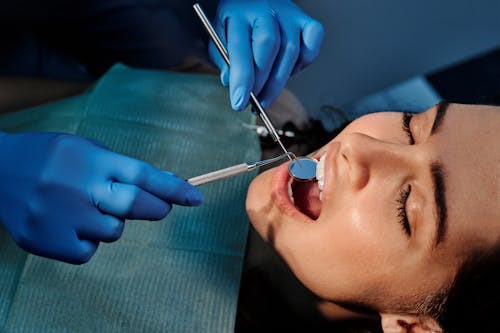
Braces play a significant role in transforming smiles and enhancing overall dental well-being. In the United States, approximately four million individuals are currently wearing braces, with a staggering 80% of them being teenagers. Furthermore, around 25 to 50% of all children are expected to undergo orthodontic treatment at some point. This trend emphasizes the critical need for effective oral care during this transformative phase. The percentage is notable for adults, as 1.6 million adults, about 20 to 25% of all patients, also benefit from braces. In Chesapeake, VA, residents can access exceptional orthodontic services, ensuring that individuals of all ages can achieve the straight and confident teeth they desire.
Here are some tips to help you navigate the challenges of getting braces and restore your smile:
Braces work by applying gentle pressure to teeth over time, gradually shifting them into proper alignment. This adjustment not only enhances aesthetics but also promotes better function and health. When teeth are aligned correctly, they enhance bite function, making it easier to chew and speak. Additionally, straight teeth are easier to clean, reducing the risk of cavities and gum disease. Overall, braces serve as an essential investment in long-term oral wellness.
With so many options, selecting a skilled orthodontist in Chesapeake, VA, is crucial for a successful treatment experience. Simply search the keyword for the best orthodontist near me in Chesapeake, VA, online to access top-tier oral care, such as Woodard Orthodontics. They provide various services, from traditional braces to modern Invisalign options. With a focus on delivering first-rate care, Dr. Woodard and her dedicated team help patients attain healthier, more vibrant smiles. Their commitment to oral wellness shines through in the quality of care available to families at their dental practice.
Routine visits to the dentist are vital during orthodontic treatment. These appointments allow professionals to monitor progress, make necessary adjustments, and address any emerging issues. Regular check-ups can help catch potential problems early, ensuring a smoother journey to achieving straight teeth. Dentists also provide essential cleanings, contributing to overall dental health.
Effective oral hygiene is critical for those undergoing orthodontic treatment. Individuals should brush their teeth at least twice daily and floss once daily to remove plaque and food particles around brackets and wires. Using a soft-bristle toothbrush and specialized orthodontic floss can make cleaning easier. Rinsing with an antimicrobial mouthwash can also help prevent cavities and gum inflammation. Establishing a consistent routine is key to maintaining a bright and healthy grin throughout treatment.
What you eat can significantly impact the success of orthodontic treatment. Certain foods can damage braces or cause discomfort, so it’s important to be mindful of dietary choices. Hard and sticky foods like nuts, popcorn, and caramel should be avoided as they can break brackets or wires. Instead, focus on softer options like yogurt, mashed potatoes, and cooked vegetables. Staying hydrated and choosing tooth-friendly snacks can contribute positively to overall oral care during this time.
Experiencing some discomfort is common when starting or adjusting to braces. Patients may feel soreness or pressure, especially after appointments when adjustments are made. Over-the-counter pain relievers can help alleviate discomfort. Additionally, applying a cold compress to the outside of the mouth may reduce swelling and numb the area. Soft foods can also make eating more comfortable during these adjustment periods. As the mouth becomes accustomed to the braces, discomfort typically lessens.
Once braces are removed, retainers play an essential role in preserving the teeth's new alignment. These custom-made devices help prevent teeth from shifting back to their original positions. It's vital to wear retainers as directed by the orthodontist to ensure lasting results. Patients should keep retainers clean and stored safely when not in use. Proper maintenance of retainers is equally important; regular cleaning can prevent bacteria build-up, ensuring oral hygiene remains a priority even after treatment.
Occasionally, patients may face orthodontic emergencies, such as broken brackets, loose wires, or poking elements. When these issues arise, it’s important to address them promptly to avoid complications. If a bracket breaks, it’s best to keep it and contact the orthodontist for guidance. In cases of loose wires, using a pencil eraser can help push the wire back into place or create a comfortable position until professional help can be sought. Knowing how to handle these situations can minimize discomfort and maintain the effectiveness of treatment.
Beginning orthodontic treatment at an early age can have significant benefits. Early evaluation allows orthodontists to identify potential issues before they become more complex. Intervening at a younger age can simplify future treatments and improve outcomes. In many cases, early treatment can guide jaw and teeth growth, reducing the need for extensive corrective work later. Educating parents and guardians about the importance of early evaluations can lead to healthier dental development for children.
Completing orthodontic treatment is an exciting milestone. Patients should take pride in their new smiles and enjoy the confidence that comes with them. Maintaining good oral hygiene and regular dental visits is important even after braces are removed. Continuing to care for teeth ensures that they stay healthy and that the effects of treatment last. Celebrating this transformation can motivate individuals to embrace their new smile fully, showcasing their hard work and dedication to oral health.
Braces are more than just a cosmetic enhancement; they are an investment in better dental health. From understanding their role to choosing the right orthodontist and maintaining a consistent care routine, each aspect contributes to a successful treatment journey. By adopting effective oral hygiene practices, managing discomfort, and following up with regular check-ups, patients can enjoy a healthy, beautiful smile for years to come. The journey to achieving a perfect smile may have its challenges, but the results are well worth the effort.